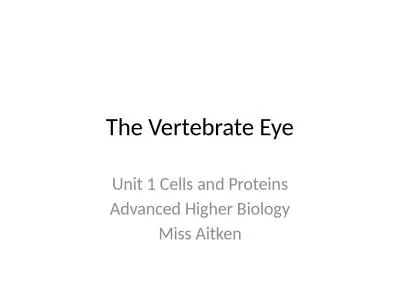

Advanced Higher Biology Miss Aitken The Vertebrate Eye In the eye of all vertebrates there is a structure called the retina The retina contains two types of photoreceptor cells Photoreceptor cells are cells that detect and respond to light ID: 913800
Download Presentation The PPT/PDF document "The Vertebrate Eye Unit 1 Cells and Prot..." is the property of its rightful owner. Permission is granted to download and print the materials on this web site for personal, non-commercial use only, and to display it on your personal computer provided you do not modify the materials and that you retain all copyright notices contained in the materials. By downloading content from our website, you accept the terms of this agreement.
Slide1
The Vertebrate Eye
Unit 1 Cells and Proteins
Advanced Higher Biology
Miss Aitken
Slide2Slide3Slide4The Vertebrate Eye
In the eye of all vertebrates, there is a structure called the retina
The retina contains two types of photoreceptor cells
Photoreceptor cells are cells that detect and respond to light
The two types are called Rods and Cones.
Slide5The Vertebrate Eye
Rods function in dim light but don’t allow for colour perception
Cones function only in bright light and are responsible for colour vision
Slide6Detecting Light
In eyes, a light sensitive molecule called retinal captures light energy.
Retinal comes from Vitamin A – carrots!!
Retinal is a prosthetic group to a polypeptide called opsin = rhodopsin
The rhodopsin complex is embedded in the cell membrane inside photoreceptor cells.
Rods contain rhodopsin to detect low light levels
Cones contain
photopsins to detect colours
Slide7Rhodopsins (in Rod Cells) and Photopsins (in Cone Cells)
There is a pathway to stimulate both of these molecules.
Slide8Rod Cells, Rhodopsin and
the Nerve Impulse
In darkness:
Rhodopsin inactive
Rod cell produces molecules called cyclic GMP (cGMP)
cGMP binds to ligand-gated Sodium (Na+) channels, keeping channels open so sodium ion flow across the membrane
Membrane depolarisedNo nerve impulse generated
Slide9Rod Cells, Rhodopsin and
the Nerve Impulse
In light:
Retinal absorbs light, causing a conformational change, making rhodopsin active (
photoexcited
rhodopsin)
Change in the rhodopsin activates hundreds of molecules of a G protein called
transducinThis activates hundreds of molecules of an enzyme called phosphodiesterase.Phosphodiesterase causes breakdown of cGMP, causing Sodium channels to close, stopping Sodium ions moving in.
A sufficient build up of sodium ions causes hyperpolarisationGeneration of a nerve impulse
Slide10Rod Cells, Rhodopsin and
the Nerve Impulse
When light hits the rod cell, a protein cascade occurs:
Rhodopsin ->
Transducin
-> Phosphodiesterase -> Channels
This method has a high degree of amplification, meaning a single photon results in a large effect. This means rods are extremely sensitive, even in low light levels.
Slide11Essay Question
Describe the role of photoreceptors (rods and cones) in triggering a nervous impulse in animal eyes (8)
Slide12Rhodopsin is the light sensitive molecule/protein in rod cells (1)
Rhodopsin is retinal combined with opsin (1)
Cone cells are sensitive to specific/different wavelengths/colours (1)
In cone cells, different forms of opsin combine with retinal (1)
Very high degree of amplification in rod cells (1)
...which means rod cells are sensitive in low light intensities/situations (1)
One photon can stimulate rhodopsin (1)
A cascade of proteins amplifies the signal (1)Hundreds of G protein molecules are activated (1)Activates hundreds of enzyme molecules (1)Enzymes generate a product (1)Sufficient product made leads to a nerve impulse (1)
Slide13Cones
Less sensitive than rods
Less photoreceptor cells
Instead of rhodopsin, they have
photopsins
Photopsins are made by combining different forms of retinal with opsin
Three types – red, green and blueAll
photopsins have different sensitivities to different wavelengths of light